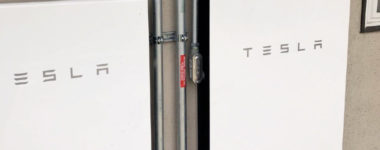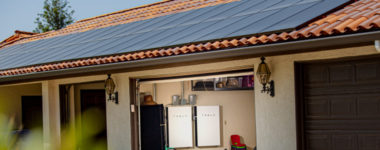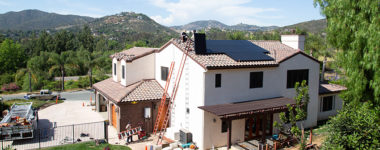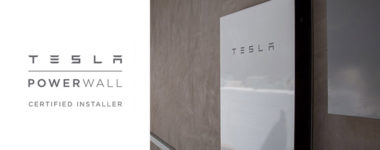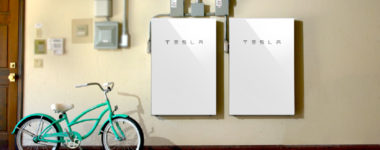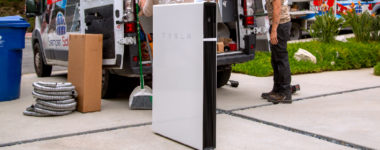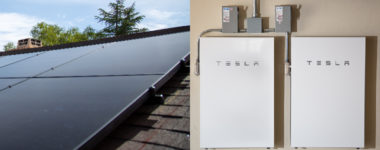Battery Storage | Solar Panels, Battery Storage, Roofing, HVAC
Extreme weather events are inevitable no matter where you live. Recently, the normally mild state of Texas experienced the arrival of a harsh winter storm that brought unusually frigid temperatures, snow, and ice. A power outage only compounded the effects of this cold weather disaster. In California, residents frequently struggle with extreme weather that is opposite to what has been afflicting Texans: dangerous, out-of-control wildfires that lead to extensive power outages. Florida also repeatedly sees vicious storms and hurricanes that wipe out electricity for days on end. During the extreme weather that so many states across the country have been experiencing in the past decade, the importance of having a reliable solar energy storage system is more important than ever. There is nothing quite as dangerous as losing the ability to heat your home in chilling, subzero conditions, or the lack of air conditioning during hot, stifling weather. Independence from conventional power sources is currently one of the few ways to navigate the challenges that power failures bring. This is where the importance of an alternative energy source comes in. Rooftop solar panels and the Tesla Powerwall together serve as a viable solution. The costs of installing an alternative energy system can seem steep at first glance. However, the price is more than worth it when it comes to saving money on electricity and having access to power during an outage. Even during non-emergencies, the ability to reduce an expensive electric bill is always a plus. Solar panels gather energy from the sun throughout the day, while the Tesla Powerwall serves as solar batter storage that you can utilize to accumulate energy for nighttime use or for a time that you truly need it. Depending on the solar panel company, these alternative energy systems can last from anywhere between 10 and 25 years before a replacement is due. Most companies offer 10-year, 25-year, or more warranties just in case of any premature malfunctions. The Tesla Powerwall is an excellent addition to most types of solar energy system, including the Silfab, Q-Cells, Tesla Solar Roof or power system. Powerwalls from Tesla have an energy usage capacity of 13.5 kWh and come with a 10-year warranty. The Tesla Powerwall is also easy to program so that it will automatically switch to stored power during the night or the moment the electricity goes down during a storm. Temperature resilience is another added benefit to these Powerwalls, which makes them suitable for most hot to moderate climates if you choose to install them outside. They function in temperatures as high as 122 degrees Fahrenheit (50 degrees Celsius) and as low as minus 4 degrees Fahrenheit (minus 20 degrees Celsius). Depending on individual homeowners' budgets or household needs, anywhere from one to several installed Powerwalls could be necessary. For the average household, it is better to install two Tesla Powerwalls than one. A single Powerwall restricts energy to minor, low consumption functions such as outlets, power circuits, and lights. A double Powerwall installation is more suitable for most homes so that appliances that take up more energy can also receive enough power to function. With two Powerwalls instead of one, your electricity use can go on as usual during an outage without the need to reduce energy usage to bare necessities. Depending where you live, a snowstorm, hurricane, wildfire, or other unanticipated event of severe weather could kill your power for several days and leave you without running water, heat, or air conditioning. This is not only inconvenient, it is potentially deadly if you are unable to warm or cool your home during extreme temperatures. With the rapidly heating global climate, unusual weather events have continued to increase around the world. The Tesla Powerwall combined with a rooftop solar energy system provides homeowners with a self-sustaining energy source that will keep the lights on during even extended power outages. With sky-high power bills and reoccurring storms or fires, green alternative energy sources can save you a lot of money and inconvenience. While the costs of a solar energy system in addition to a couple of Powerwalls costs several thousand dollars, the price is well worth it when it comes to being able to keep your power on during unavoidable natural disasters.
The expansion of clean energy grows as an innovative solution to energy needs in the United States. Solar panel systems are becoming an energy source that plays a revolutionary role in meeting energy needs, which has fueled their rapid growth in the United States. According to SEIA (Solar Energy Industries Association), the solar market has not stopped growing since it doubled in 2016. Solar battery storage is playing a leading role in the advancement of solar energy. States that promote solar panels and solar battery storage will lead to an unmistakable solar industry trend. What is the last? SEIA has presented an ambitious vision for expanding clean energy in the US to the 117th US Congress. Aware that a new administration will take over in 2021, SEIA recently adjusted its vision for clean energy policies to help solar have at least 20% of generation by 2030 and accelerate the transition to a clean energy economy. SEIA, through one of its directors, announced on October 29, 2020, that Arkansas Group joins the National Solar Trade Association to strengthen solar defense in the southeast. Now the Arkansas Advanced Energy Association (AAEA) is an official state affiliate of SEIA. If you want to be part of this growth, you can participate in SEIA's Solar Goes Corporate. In this forum, buyers and suppliers of clean energy converge, designed to discuss how companies can effectively invest, acquire, and implement clean energy technologies such as solar energy and batteries' storage. The solar energy boom has brought with it the emergence of other renewable technology such as solar batteries capable of storing additional solar energy for later use. In this sense, companies like Tesla develop batteries combined with solar panels to create "solar + storage" systems for domestic and industrial use. Get an informative summary of the basics of solar + storage and SEIA's role by clicking on the following link: Solar + Storage. We invite you to read on to learn more about clean energy and determine if you should consider installing a solar plus storage system for your home. Keep in mind that the cost of solar energy has been falling across the country. Why Choose Solar + Storage? To consider why you may choose to install a Solar + Battery Storage system in your home, you must first understand how a solar PV system like the standard home works. The standard of a solar energy system includes: Solar panels, A kit to mount the panels on your ceiling, An inverter, A performance monitoring system that tracks electricity production. Solar panels concentrate energy from the sun and transform it into electricity, which passes through the inverter and is converted into energy used to power your home. By solar policy, residential solar energy systems must be connected to the electricity grid. This allows the exchange of energy. When your panels make more electricity than your home requires, the excess travels to the power grid. On the contrary, when your solar panels cannot supply your home's electricity demand, you can obtain energy from the electrical grid. Also, by solar polity, you will receive a credit on your electricity bill for helping the utility company by delivering excess power to the grid. Of needing more electricity than your solar panels can generate, you can use those credits instead of paying more for your utility. This process is known as net metering. In all this, the plus is given by the batteries. Solar politics energy storage can smooth electricity prices through arbitrage. It can also mitigate reduction risk, manage nighttime power ramps, provide black start capability, provide backup power, and more. Many solar energy companies like the California Solar Company see storage as a business growth opportunity. They see solar system owners as their allies. This is due to solar politics and to the fact that to achieve 20% of the total electricity generation that the solar industry is targeting, it relies heavily on cost-effective integration of storage. How Is The Storage Of Solar Batteries? The function of solar batteries is to store the energy produced by your solar panels for later use. According to technology, there are solar batteries that come with their inverter and offer integrated energy conversion. The storage is directly proportional; the greater your battery's capacity, the greater its electrical energy storage capacity. At Semper Solaris, a California Solar Panel installation company, they recommend always installing a solar battery as part of your solar panel system, as that allows you to store excess solar electricity in your home rather than send it back to the grid. If your solar panels make much more electricity than required, the excess energy is deposited in the battery. That will decrease the energy exchange with the grid. It will only send electricity to the grid when the battery is 100% charged, and it will only receive electricity from the grid when the battery is low. As you can see, houses with solar energy plus storage will be able to store excess energy for use when in contingency or when the sun doesn’t shine. They have the additional benefit of having short-term backup power in the event of failures in the public service network. Installing A Solar Battery In Your House Is An Opportunity? SEIA is firmly supporting the creation and improvements of an Investment Tax Credit (ITC) for energy storage; it is part of what it has submitted to Congress. Installing a solar battery is synonymous with saving money, which largely depends on solar politics and how the utility company compensates you for your solar energy. With full net metering, you typically receive credits on your electricity bill for every kilowatt-hour of electricity your solar panels produce, so you don't use them right away. However, it may not be so. The trend is for a solar battery to help improve the economy with solar panels for your home or business. Solar battery storage can help you save more, as long as your solar energy supplies your electricity demand. But if the utility company has times of use rates or demand charges or simply does not offer net metering. Not only that, Solar Panels and Battery Storage can help with Sleep Apnea and CPAP Machines even when the electricity goes out. How Does Solar Grid Storage Fit Into The Broader Electrical Ecosystem? Solar batteries and other energy storage technologies are set to become a market of around $ 2.5 billion in the United States by 2020-2021. Why is Energy Storage Expected to Grow so Fast? For the benefits that solar battery storage offer to their owners, such as those of homes, that is: Renewable electricity storage capacity for later use, Ease of application on a larger scale for the entire electrical network. Depending on the technology, they provide more flexibility in the generation and use of electricity, mainly from solar and wind energy. Utilities have a complex task. They need to provide their customers with a reliable and quality service. To do this, they must ensure that they have enough electricity on the grid to meet demand. Otherwise, there can be fluctuations in service and even have dissatisfied customers from experiencing blackouts. For increasing solar battery storage, incentives are needed in that direction. This will help network and utility operators manage their electricity flow operations from renewable resources with more flexibility. In the long term, it means there will be more renewable energy resources built into our nation's electricity mix, where home solar panel systems will be a major stronghold.
The sun is an all-natural alternative energy source that produces radiation you can turn into electrical and heat energy. This form of renewable energy offers plenty of benefits to those who exploit it. Harnessing the sun's rays can lower your electrical bills and cost of living, especially if you live in a major city like San Jose. The city is usually associated with wealth and is considered a modern metropolitan area. San Jose is believed to have one of the most highly-priced housing markets in the globe. San Jose has a tropical Mediterranean climate that offers more than 300 days of sunlight per year that is ideal for harnessing solar energy on a residential or commercial scale. A standard solar installation should come with solar panels, a DC-AC inverter, and a UPS battery storage. The average electricity charge rate in San Jose is considered to be 31% higher than the Country's average charge rate. Investing in San Jose solar panels and battery storage can ensure you have a constant electricity supply, especially during grid blackouts. You don't necessarily have to depend on the electricity; you can reduce costs and enjoy electricity during blackouts by buying a solar panel installation in San Jose. Advantages of Investing In San Jose Solar Panels: Apart from reducing electricity costs, procuring a Solar panel and battery storage unit can offer you the following benefits: You can use solar energy virtually anywhere Solar rays can be harnessed virtually anywhere across the world as long as the sun is shining. All you need is a solar panel to capture the sun's energy and a battery storage unit to store the electrical power. If you live in remote areas in San Jose, buying a solar harnessing solution may be best for you. If your premises are off the grid, solar energy can be a cheap yet effective electricity source. It is more environmentally friendly The normal electricity people use at homes is usually generated by burning fossil fuels, conducting nuclear reactions, and, to a lesser extent, harnessing hydroelectric and wind power. The sun offers the best alternative energy that has the least negative effect on the natural environment. Solar energy doesn't release any harmful fumes and doesn't affect water negatively. Moreover, solar energy is silent; even if you live in urban residential places, you will generate and store energy without polluting the environment in any way. You get a free federal tax credit and additional incentives for using solar energy When you buy solar panels and San Jose battery storages, you will receive a tax credit. Now is the time to buy while incentives are available at a high rate. Buying a solar panel installation in San Jose can also provide you with cash rebates from the California Solar initiative. Make sure to double check the incentives available before moving forward on your purchase. Solar Energy creates opportunities and jobs Every solar energy consumer requires a qualified solar panel installer, and the increase in demand for renewable energy is creating numerous opportunities in the job sector. Buying a solar installation in the San Jose area will assist in generating income for local companies. The Straight Forward Process of Acquiring Solar Panel Installation in San Jose First of all, consider if you are eligible for low-income solar services that offer a wide range of reimbursements and incentives. Also, identify whether your roof requires repair before the installation. It’s usually smarter to hire the best roofing company in San Jose than doing repairs yourself. It would be best if you also identified additional ways of making your home/ premises more energy effective as you buy a solar panel solution. Procuring energy-saving lights together with solar energy can greatly reduce electrical costs. As mentioned earlier, having a solar harnessing installation can offer you many benefits. Here is a step by step guide on how to acquire a San Jose Solar panel. Start by identifying your premises' solar capability Depending on the residential or commercial premises, there are various potentials you can exploit with solar energy. Nowadays, you can use digital tools such as the Google project Sunroof software that use a real-life professional to suggest suitable solar solutions for your premises. Find a suitable contractor to install the solar harnessing system It is important to hire a competent licensed contractor to ensure your solar installation is done effectively and lasts longer without the need for maintenance. Solar panel installers in California must have a permit from the Contractors State License Board. Clients can confirm whether a firm is legit by crosschecking its license number on the Contractors State License Board official web page. Weigh your payment options There are numerous firms out there offering solar services. If you have the cash up front, consider solar installation firms with the best offers and those that come with additional features. If you don't have the money, other financing options include leasing and hire purchase options. Review and understand all the relevant paperwork Understanding your solar installation contract's terms and conditions can help you comprehend important aspects of your San Jose battery storage and solar panel. Such aspects include Warranty covers, total costs, and a checklist of the installed equipment. Ensure the contractor applies for the necessary San Jose permit Before you can install a solar harnessing system, you need to get a permit from the city of San Jose. This permit can be obtained through an online application. The process will schedule a premises inspection, after which you can plan for the installation of a San Jose solar system. Schedule the solar panel installation Once all requirements are met, you can plan for a residential or commercial installation. After the process, you can enjoy solar energy and the advantages that come with it. Conclusion Investing in solar panel installation solutions in San Jose can reduce energy costs, among other benefits. The process of acquiring a solar energy solution is quite straightforward, especially if you know and fulfill the set requirements. To learn more or to book an appointment, contact us today via our appointment booking form.
With the help of solar battery storage, you can keep the excess energy that your solar panels produce during the day. So, it provides you the option to use that stored excess energy as and when you need it. Most homeowners use it during a power outage or other such similar scenarios. However, recently many are using it to control their utility rate and also to increase their savings. Thus, it is no wonder that more than 50% of the US population is considering adding a battery to their existing solar battery installation. When diving into the world of solar batteries, the very first thing which a homeowner notices is a price. So, it is quite natural for a homeowner to know how long the charge of a solar battery will last or what is the life expectancy of the selected/wish-listed solar batteries before going for this kind of significant, long-term investment. How long will the charge on battery storage last for? Well, home solar battery units usually last for 5 to 20 years. In fact, many manufacturers and suppliers guarantee that you won't need to replace the batteries until after almost 30 years from the date of purchase. This development is rather recent, along with the increase in the life expectancy of solar panels. Such an advantage is expected from solar batteries as well. However, it is tough to procure the exact hours the charge of the solar battery in question will last. Based on the type, model, kind, capacity, size of the solar battery, and the amount of charge provided to it, a standard battery charge lasts for 1 to 5 days’ load. Specific batteries, like Tesla Powerwall, will give 7+ continuous days of power.** So, it is quite clear now that the charge will be affected by the types of battery and along with factors known for impacting the solar battery’s lifespan and capacity. Thus, to provide a clearer picture; next, we will discuss the different factors affecting the battery life along with the best types of solar battery known for holding the charge for an extensive amount of time: Types of Solar Battery There are three popular solar battery types which are known for lasting for a long time after a single proper charge, and they are: Saltwater Battery Instead of heavy metals, it depends on saltwater electrolytes. These are environment-friendly and recyclable. Lead-Acid Battery Even with a lower DoD (Depth of Discharge) and shorter lifespan compared to the next type, lead-acid battery works well and is affordable. Lithium-Ion Battery This type is more expensive than both types discussed above; however, it is one of the best options to go with if you are looking for a solar battery that has reasonable charge retaining capacity. Saltwater and lead-acid are indeed great performers; however, the charge of lithium-ion solar batteries will last longer than the other two. Other Factors Affecting Solar battery’s lifespan Solar Battery Charging and Maintenance A solar battery will need charging as per its type, model, and size. Only with the correct or proper amount of charging, one can enjoy the product’s potential to the fullest. Thus, figuring out the charging time/period is crucial. Similarly, taking proper care of the batteries is also essential to ensure it is in working order and is capable of holding the charge for as much time as possible. Solar Battery Temperature The temperature/atmospheric condition of where you live will also affect the lifespan of a solar battery. Thus, protecting and charging the battery adequately is necessary. Solar Battery Usage The lifespan of the battery or the charge holding capacity of a solar battery will depend on its usage cycles. Thus, it is best to go for deep-cycle batteries. They are known for only discharging around 80% of the stored energy before it re-charges. There you have it, everything you needed to know to determine how long a solar battery can hold its charge. So, before investing in a battery, is it advisable to go over the information provided by the manufacturer and suppliers, and take the necessary steps to clear any queries to figure out how long you can expect the charge of a particular battery in solar panels to last.
As per some recent studies, most homeowners believe that having a solar battery storage installation along with solar panels is one of the best ways to enjoy all the advantages that solar energy has to offer. With the help of a solar battery, Americans can store excess energy yielded by their solar power system. However, the fact that batteries are complex and volatile cannot be ignored. Thus, comes the question: "Is a home, or more specifically your home, suitable to have solar battery storage?" Battery Storage Safe for Homes Well, if you are dealing with a certified solar battery from a reputable manufacturer/supplier, then you can be rest assured that they will be safe to use. Even if the solar battery is generally considered safe for most Americans, it is still advisable to understand the safety implication of owning a home solar battery. Once you enter the world of home solar batteries, you will see that there are top three contenders. Lithium-ion batteries, lead-acid, and saltwater batteries come with their own set of pros and cons. However, it is safe to say that all these three types are compatible with most standard home solar systems. So, you cannot go wrong as long as you choose any one of these three as your home solar battery storage option. It is essential to mention here that if you go for lithium-ion batteries (the most popular choice), then make sure that the one you pay for is of high quality and is installed correctly. This type will only become a safety risk than alternative technologies when they are of low quality and/or is not installed correctly. The issue mentioned about lithium-ion solar batteries may sound risky. But, with proper installation and with the best product, this can be avoided easily. So, here comes the necessity to know how to procure the best solar batteries and how to properly install them so that you can keep your home safe. Choosing a High-Quality Solar Battery Most batteries available in the American market are produced by established manufacturers. So, you can expect that the batteries will meet all the general industry safety rules and regulations to be sold for homes. The batteries will come with certificates proving that they will be safe for your home, so do make sure to look into it before paying. If you have a problem with shopping by yourself, then you can let your installation company suggest the appropriate one. Choosing a Reputable Solar Battery Installation Company Going with a reputable battery storage installation company is a must to ensure that you have the best product which is being installed accurately with experienced hands. Even though it may look easy, but installing a solar battery required specific skills and electric expertise. Hiring a qualified professional company is advisable as they can offer you the help you need to make the battery safe for your home. Only with the assistance of a professional, can you get the best recommendation as per your home and solar power system. They are certified experts having state-of-the-art equipment to take on the installation process effectively. They follow safety protocols while providing their affordable services to ensure the homeowner's property is not damaged. Semper Solaris is the #1 supplier and a certified installer of Tesla Powerwall, the most intuitive and easy to use lithium-ion battery on the market. Powerwall combined with an existing solar panel system, or the electrical grid, can save you money and power your home with clean, safe energy all year long.
There are many ways that you can gain an advantage from installing backup battery storage with your solar panels. The backup battery stores power from your panels, which can be used during the time your panels are not producing electricity. You can save money if you use power during high peak hours when the cost of electricity is high. And it will keep your electricity on during a power outage. Backup batteries for solar power installations are becoming more efficient, more useful, and the prices have dropped considerably. Solar backup battery installation in El Cajon is attractive to homeowners and much more affordable. After the solar panel installation, they are the next step towards energy independence. How Solar Batteries in El Cajon Work Blackouts can occur when there is an incident that cuts the transmission of power from your utility company to your home. This type of disruption of power is often temporary, lasting only a few hours. But outages can occur when you least expect it. Your solar panels produce electricity from sunlight. The energy from the panels converts to AC power for your home, and the excess power feeds back into the grid. Your utility company operates as a mega backup battery storing the excess energy from your panels for later use. However, during a blackout, that auxiliary power is not available to your home. Solar Battery in A Power Outage During a power outage, your solar panels will continue to provide power to your home while the sun is shining. But they will stop producing energy when the sun goes down. The addition of a solar battery backup will keep the power on using stored energy to power your home. Your solar panels will keep your power on in a power outage if there is daylight. But once your solar panels stop producing energy for the day, your lights will go out along with everything else that runs on electricity. Solar Battery Storage in El Cajon allows you to keep the power on in both short term and long-term blackouts. A solar battery will keep your power running seamlessly. And when the sun rises in the morning, your panels will be back at work generating and providing electricity. With the addition of a backup battery, you can keep the power going for days and weeks if necessary. Solar Backup Batteries Save Lives Longer-term blackouts can occur when emergencies or natural disasters arise, like earthquakes, fires, floods, or other catastrophic events. Backup battery storage adds a layer of safety and peace of mind that is more than worth the price of the battery itself. El Cajon is in an area at high risk of wildfires. In a fire, it is essential to have your HVAC system running to filter particulates and contaminants that can enter the home. And in California, the danger of earthquakes is a likely event. In the event of a long-term blackout where communication is a necessity, solar power, and solar panel battery storage in El Cajon may save lives. Accessing emergency services, receiving evacuation orders, and knowing where to go could mean the difference between life and death. Solar equipment provides power for disaster relief all over the world. It only makes sense that solar panel installation, along with a backup battery, is an invaluable safety measure for your family. What to look for in Solar Backup Batteries There are several specifications to look at for storage batteries. The most important ones are the following: Capacity and power - how much power can it store? Depth of discharge – how much power can it produce? Efficiency – how much of the stored power is usable? Battery life – how long does it take the battery to empty? Semper Solaris technicians are experts in the installation of solar power along with solar backup storage. We use only the highest quality solar batteries, such as Tesla Powerwall or Enphase Encharge Battery, and we offer both the manufacturer and installation warranties on all batteries. In fact, we are a Tesla Powerwall certified installer, making us the most reputable solar contractor for your solar batteries in El Cajon. Call us today, and we will get you on the road to solar energy storage.
Several years ago, Elon Musk steered Tesla Motors into the renewable energy market with an innovative home energy storage product – Tesla Powerwall. This home battery is designed with the same dedication to detail and innovation as Tesla’s cutting-edge electric vehicles and other ventures. While Tesla certainly didn’t invent solar storage batteries, they certainly used their reputation as a leading-edge tech and renewable energy-conscious company to launch their Powerwall into a mostly untapped market. With Tesla’s stamp of approval, new buzz and interest have surrounded the prospect of storing solar energy created by a home’s solar panels. So what exactly is the Powerwall? According to Tesla, it is a small-scale rechargeable lithium ion battery that provides homeowners with more access to self-sustaining energy for their homes Understanding Tesla Powerwall These batteries are designed for optimal use with a solar panel system. How does having the Powerwall installed change the game for homeowners with solar panels? It gives them much more independence from the grid when it comes to energy needs during low production times. Essentially, the Powerwall allows a homeowner to fully control their electricity production and usage by storing home energy for later use. As would be expected, Tesla spent a significant amount of time and energy developing the Powerwall into a reliable, effective home battery for regular use. The battery works by storing any excess electricity your solar panels produce vs. allowing that electricity to be sent back to the grid (usually for a credit in most states). Even in states with a credit, homeowners are still technically “buying” electricity from the grid when their panels don’t produce electricity at certain times. The battery allows any surplus to be stored and used during these times rather than grid dependency. While a single Powerwall battery won’t enable you to go completely “off the grid,” it does allow you much more freedom and starts to transition your home towards being much more self-sufficient. How Long Will Tesla Powerwall Last? Tesla backs it Powerwall up with a completely unlimited 10-year warranty. This warranty covers daily charging and usage, so essentially as much wear and tear as possible. The warranty also guarantees that a home’s Powerwall will maintain a minimum of 70% of its full charge capacity over this time. It is typical for batteries to lose some of their ability to maintain a charge with usage. Is Tesla Powerwall Right for Your Home? Adding a solar battery to a home solar panel system isn’t right for everyone. Further, solar batteries are still pretty new to the market, meaning the technology will continue to improve with time. If you have a utility system that provides net metering for solar panel owners, a solar battery may not be as necessary. In comparison, homeowners in areas that enforce time-of-use rates for electricity would be wise to consider investing in a solar battery to curb their expenses. Finding out if a solar battery is a good investment for your home starts with talking to a solar expert. Semper Solaris is a Tesla Powerwall certified installer and can answer any questions you have about Tesla Powerwall or similar solar energy batteries.
There has been a rising interest in solar battery storage in recent years. While most homes are still tied to power grids, a solar battery like Tesla Powerwall would allow homeowners to move closer to being “off the grid” for good. For most, the allure of complete autonomy when it comes to electricity production and usage is very enticing. One of the biggest perks of having a solar panel system is to provide more self-sufficiency, after all, and a solar storage battery is just another step towards independence from utility companies that continue to hike electricity prices. That is why we are going to take a look at the benefits and pitfalls of both traditional grid-tied solar power systems and solar power systems backed by battery storage. How Does a Grid-tied Solar Power System Work? Having a solar power system for your home gives you much more control over your electricity usage. You are able to harness the power of the sun and convert it into usable energy, majorly cutting back on utility expenses. But will solar panels produce enough power for your home? What about those times when the sun doesn’t shine through the clouds or a stormy day hampers energy production? For most homeowners, the solution is being tied to a power grid. For any energy demands they have that their solar production doesn’t cover, they will start pulling from the power grid instead. Even though homeowners essentially have to “buy” energy during these times, they often have credits to cover the expenses. This means that during evening hours without sunlight, cloudier days, or other circumstances, homeowners can still ensure their electricity needs are covered -- and still benefit from previous over-production of electricity needs. In some states, homeowners can even earn money for any additional electricity their panels have produced that they don’t use from the grid. There is also great assurance knowing that there will always be some source of power to pull from should a home’s solar panels not provide the electricity needed. As states continue to adopt models for charging solar panel customers, power companies stand to benefit the most from having customers still tied to the grid. This also means that the threat of facing time-of-use rates and other spikes in utility costs is still very real for homeowners with a grid-tied solar power system. How Does a Battery Storage Solar Power System Work? In theory, a solar power system that has a solar storage battery could be completely grid-free. That means homeowners have ultimate control over their electricity needs. They don’t have to worry about using credits to cover additional energy demands during low production hours, time-of-use rates, or other challenges that come with a regular grid-tied system. Battery technology isn’t new, but using batteries for home solar power storage is still not widespread yet. However, the interest in energy storage is growing greatly. As products continue to be developed, the efficiency and storage capacity of these batteries will continue to improve. However, some home electricity demands would still exceed the storage capacity of a solar battery. If you tried to go completely “off the grid,” you could be left without power once you depleted your backup resource until the sun comes back out. Why a Hybrid System Is Gaining Popularity It is clear that both a grid-tied system and battery-backed system boast plenty of perks – and challenges alike. Instead of weighing the pros and cons to the point of pulling out your hair, consider an alternative solution: a hybrid system. A hybrid solar power system can include the pros of both sides, while essentially eliminating the cons. A home can have the perks of being tied to the grid for any energy needs they have once they’ve used up their solar panel production and battery storage. Homeowners have the ability to draw electricity from both their local power grid, as well as from their home solar batteries. They can choose to invest in more solar batteries for more independence overtime or simply get one for backup purposes. Having a hybrid system also gives homeowners more flexibility and control. They may choose to reserve their solar power storage for emergency usage only, after the sun goes down, or as backup in case electricity prices surge during certain hours of the day. Combining a grid-tied system and battery system allows for a consistent and more controlled flow of energy throughout the day and night for homeowners. When is a hybrid system the most desirable? For homeowners who live in an area without favorable compensation rates for excess electricity produced by solar panels, having a hybrid system can be crucial. Rather than simply sending excess electricity to the grid at a low rate, a homeowner can save some of that valuable electricity for future use, only sending what they don’t use or store. How California’s Net Metering Policy Has Changed Homeowners who live in California may be even more inclined to consider a hybrid solar power system. Net Metering 2.0 (NEM 2.0) is an update to California’s original policy on net metering, now including time-of-use rates, non-bypassable charges, and some additional fees. The estimated additional cost will jump up to around $10/month for an average homeowner. The time-of-use rates will be the biggest adjustment for many homeowners, which will adjust the credit given for solar electricity depending on the time of day it was produced. Typically, any excess electricity that is sent back to the grid during higher demand or peak hours will be given more credit. Overall, the policy is still favorable for homeowners, but having a solar battery to store excess electricity can provide more flexibility to bypass lower time-of-use rates and send by electricity during those peak value hours. Whether you are considering completely disconnecting from your local power grid with solar storage batteries or just want to create the most efficient home solar power system, talk to Semper Solaris about your battery options today.
